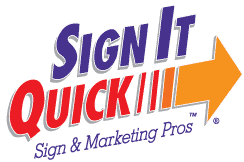Choose Your Location


Connect here for exclusive promotions, discounts & more!
The Sign It Quick experts can advise you on the readability of your signage.
How large should the letters be? What color can be read easiest against what background? What angle does your sign need to be read from? What about the height of your sign? So you decide who needs to read your sign, and work with our expert team to make those decisions together.
Creating a sign is only part of the process. Your signs need to be read easily and that involves decisions like letter size, spacing, background color and lettering and graphic color. Did you know that the background color can often make the biggest impact in readability? Also, placement of your sign can be critical to whether or not your sign is easy to read. These are all important reasons why you are going to enjoy and appreciate working with the Sign it Quick team in making all these vital determinations.
ELEMENTS OF EFFECTIVE SIGN DESIGN
Visability:
Your sign’s size will determine the height of the lettering you should use. We recommend one inch of letter height per 10 feet of viewing distance.
Readability:
Less is usually better. Your Sign It Quick Custom Signs Expert will help create maximum readability for your custom signs and banners. Larger, bolder letters and additional colors can add emphasis, as can attractive graphics.
“Eye-Catchability”:
The color you use in your sign should contrast well with the environment in which it will be placed. Use of eye-catching graphics is important to your sign’s overall impact, also
Legibility:
Letter style is crucial to legibility. Avoid using fancy script lettering – especially when signs or banners must be read from a distance.
Here’s a quick tip to figure out how big your lettering can be. Determine how wide your signs (and banners) will be (measuring from left to right). Count up the number of letters and spaces on each line of wording, beings sure to leave one space at the beginning and end of the line. Divide the length of the sign by the total number of letters and spaces to determine how large the letters can be. So, say your sign is 42 inches across and it needs to read “Registration” on one line, with an arrow beneath it pointing to the registration building. Allowing for a space on either side of the word, that gives you 14 characters; divide 42 by 14 and you realize you can use three-inch lettering, depending on the letter style.
As for signage readability, the chart below lists various letter heights, along with distance for optimal reading, as well as maximum readability distance.
Take a look at the various font styles below before deciding on the lettering for your sign.
FONT STYLES
Serif:
Serif fonts project a more sophisticated upscale image. They also make it easier to read large bodies of text.
Sans Serif:
Sans Serif fonts project a strong durable image. They also effectively communicate quick bursts of information.
Script:
Script fonts project an elegant image. Unfortunately they are often characterized by poor legibility. They should only be used for short viewing distances and only in combinations of upper and lower case letters.
Display:
Display fonts project distinctive images for special situations. Legibility is also a concern especially over greater viewing distances.
Charleston, SC
Columbia, SC
Jacksonville, FL